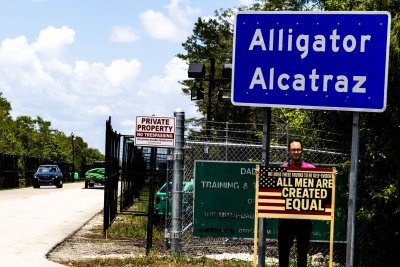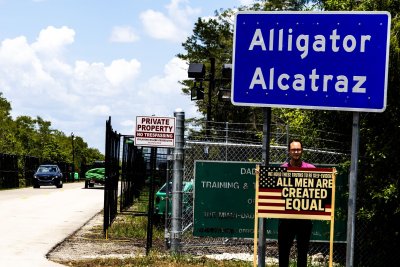
Aug. 6 (UPI) — A federal judge in Florida on Wednesday heard arguments from two groups seeking an injunction to halt the operation and further construction of an immigration detention center in the Everglades called “Alligator Alcrataz.”
District Judge Kathleen Williams conducted a hearing in Miami on a lawsuit by environmental groups and the Miccosukee Tribe, claiming the state and federal government bypassed mandatory ecological reviews required under the National Environmental Policy Act during construction.
They also said the detention facility, which now houses 1,000 detainees with plans for up to 5,000, was built in less than two weeks without public notice or comment, and didn’t comply with other statutes, including the Endangered Species Act.
The detention center, which is about 75 miles west of Miami and 44 miles southwest of Naple, is amid swampland that includes alligators, pythons, snakes and other predators.
Randy Kautz, an expert in Florida wildlife, said 120 to 230 endangered panthers are in the “core area” and increased human activity will harm reproduction.
“There has been a stable reproducing population of panthers in this area in this range at least over the last 30 years,” he said in court. “Panthers have succeeded and resided here.”
Panthers were tracked in the 1,000 acres near the detention facility, which was built on a rarely used airstrip off U.S. 41 in Ochopee in Miami-Dade County near Collier County. The so-called Alligator Alley, which is part of Interstate 75, runs 80 miles across the state through the Everglades.
Attorneys say the work is exempt from the National Environmental Policy Act because it was initially funded, constructed and managed by the state. But Florida state Rep. Anna Eskamani testified the Department of Homeland Security wants the facility.
More than 40,000 people opposed the detention center in a petition on the website of the Friends of the Everglades, a nonprofit, which is one of the parties in the lawsuit.
“We are very concerned about potential impacts of runoff” and “large, new industrial-style lights that are visible from 15 miles away, even though having a dark sky designation,” Eve Samples, the executive director of the group, told the court.
“Driving out there myself many times, the increased traffic is visible. I saw two dead gators last time I visited, so definitely a difference in the area.”
The detention facility neighbors land leased to the Miccosukee Indian Tribe with villages, a school, hunting areas and sacred sites.
Civil rights groups filed a second lawsuit alleging that detainees’ constitutional rights are being violated. A hearing in that case is scheduled for Aug. 18.
WTVJ-TV reported limited access to showers, spoiled food, extreme heat and mosquitoes. They also allege they are being barred from meeting lawyers with some held without any charges.
President Donald Trump toured the facility on July 1 with Gov. Ron DeSantis and Homeland Security Secretry Kristi Noem before the opening two days later.
The first deportation flights departed from the airstrip on July 25.
Legislators in Congress and the state, who initially were denied access, were allowed to visit on July 12 but couldn’t speak to the detainees and access to the property was limited.
“Rural immigrant detention camps — 750 people in cages like animals — is un-American, and it should be shut down,” state Sen. Carlo Guillermo Smith said.
State and federal officials defend the conditions.
“All detainees are provided with proper meals, medical treatment, and have opportunities to communicate with their family members and lawyers,” Homeland Security spokeswoman Tricia McLaughlin told NBC News last month. “Ensuring the safety, security, and well-being of individuals in our custody is a top priority.”
DeSantis has said the airport site, called the Dade-Collier Training and Transition Facility, won’t have any effect on the surrounding environment.
DeSantis and Noem have touted the location because it is in a relatively remote area and surrounded by swampland.
DeSantis utilized an emergency order in 2023 in response to Cuban and Haitian migrants arriving in the Florida Keys by boat, with the state offering to pay $20 million for the land.
Florida will seek reimbursement from the federal government for the $450 million yearly cost of running the facility, a senior Department of Homeland Security official told the Miami Herald.
County officials approve the use of the airstrip for immigrants.
The airstrip was envisioned to become an airport with construction to begin in 1968. Work was halted in 1970 because of environmental concerns, but not before one runway was finished. The runway was used for training flights.
The land later became Big Cyprus National Preserve, which encompasses 1,139 square miles. The preserve is north of Everglades National Park, which covers 2,356 square miles.
